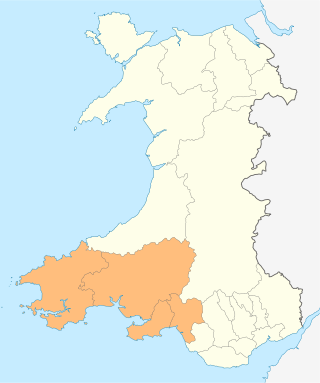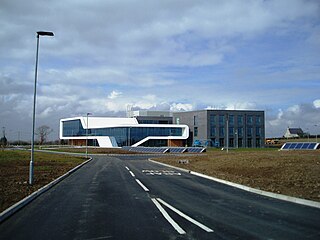
Energy in Wales is the production of electricity in Wales.

Energy in Wales is the production of electricity in Wales.
In 2018, the annual production of electricity in Wales was 30.2 TWh and consumed 14.9 TWh, which means that Wales generates twice as much electricity as it consumes and is a net exporter of electricity to England, Ireland and Europe. [1] [2] In the same year, 25% was from renewable sources, up from 22% in 2017. Electricity generation encompasses a broad mix of technologies including Coal (e.g. Aberthaw), Gas (e.g. Baglan Bay), Wind (Cefn Croes), hydro-electricity (Dinorwig), solar thermal/PV and biomass electricity.[ citation needed ]

Fossil fuels are not renewables; historically, the economy of Wales has been driven by fossil fuels. The coal industry in Wales had reached large proportions by the end of the eighteenth century, and then further expanded to supply steam-coal for the steam vessels that were beginning to trade around the world. The Cardiff Coal Exchange set the world price for steam-coal and Cardiff became a major coal-exporting port. The South Wales Coalfield was at its peak in 1913 and was one of the largest coalfields in the world. [3] In 2019 the percentage of electricity generated from coal was only 2% of total electricity generated. The last coal-fired power station in Wales was at Aberthaw, which finally closed its doors in March 2020. [4]
The total capacity of electricity generated from fossil fuels was 7.4 GW and came from three sources:

In 2018, Wales generated more than 50% of its electricity consumption as renewable electricity, an increase from 19% in 2014. The Welsh Government set a target of 70% by 2030. [5] In 2019, Wales was a net exporter of electricity. It produced 27.9 TWh of electricity while only consuming 14.7 TWh. [6] The natural resource base for renewable energy is high by European standards, with the core sources being wind, wave, and tidal. Wales has a long history of renewable energy: in the 1880s, the first house in Wales with electric lighting powered from its own hydro-electric power station was in Plas Tan y Bwlch, Gwynedd.[ citation needed ] In 1963, the Ffestiniog Power Station was constructed, providing a large scale generation of hydroelectricity, and in November 1973, the Centre for Alternative Technology was opened in Machynlleth.[ citation needed ]
In 2017, the Welsh Government announced a target of meeting 70% of Wales’ electricity demand from Welsh renewable electricity sources by 2030. By 2018, Wales generated over 3,864 MW renewable energy from 68,728 projects. [1] In 2021, the Welsh government said that more than half the country's energy needs were being met by renewable sources, 2 percent of which was from 363 hydropower projects. [7]
In 2015 a tidal lagoon for Swansea Bay was proposed, to generate electricity. However, in June 2018, the UK Government withdrew support for the plan due to independent study showing it to be not viable. [8] [9]
In January 2023, plans of a new Swansea tidal lagoon project called "Blue Eden" emerged but this time fully funded by the private sector. It would include an electric battery manufacturing plant, battery storage facility, a tidal lagoon in Swansea Bay with a floating solar farm, data storage centre, a green hydrogen production facility, an oceanic and climate change research centre. The project could start within 18 months. [10]
The Morlais tidal stream project, on the west coast of Anglesey, could deliver up to 120 MW of renewable clean energy. £31 million was secured in 2022, for the first phase of construction, from the EU's European Regional Development fund via the Welsh Government. [11] The onshore grid connection works were constructed in 2023, and Mark Drakeford officially opened the onshore substation in October 2023. [12]

Tidal power or tidal energy is harnessed by converting energy from tides into useful forms of power, mainly electricity using various methods.

The economy of Wales is part of the wider economy of the United Kingdom, and encompasses the production and consumption of goods, services and the supply of money in Wales.

The Severn Barrage is any of a range of ideas for building a barrage from the English coast to the Welsh coast over the Severn tidal estuary. Ideas for damming or barraging the Severn estuary have existed since the 19th century. The building of such a barrage would constitute an engineering project comparable with some of the world's biggest. The purposes of such a project have typically been one or several of: transport links, flood protection, harbour creation, or tidal power generation. In recent decades it is the latter that has grown to be the primary focus for barrage ideas, and the others are now seen as useful side-effects. Following the Severn Tidal Power Feasibility Study (2008–10), the British government concluded that there was no strategic case for building a barrage but to continue to investigate emerging technologies. In June 2013 the Energy and Climate Change Select Committee published its findings after an eight-month study of the arguments for and against the Barrage. MPs said the case for the barrage was unproven. They were not convinced the economic case was strong enough and said the developer, Hafren Power, had failed to answer serious environmental and economic concerns.

Energy in the United Kingdom came mostly from fossil fuels in 2021. Total energy consumption in the United Kingdom was 142.0 million tonnes of oil equivalent in 2019. In 2014, the UK had an energy consumption per capita of 2.78 tonnes of oil equivalent compared to a world average of 1.92 tonnes of oil equivalent. Demand for electricity in 2023 was 29.6 GW on average, supplied through 235 TWh of UK-based generation and 24 TWh of energy imports.

Aberthaw Power Station refers to two decommissioned coal-fired and co-fired biomass power stations on the coast of South Wales, near Barry in the Vale of Glamorgan. They were located at Limpert Bay, near the villages of Gileston and West Aberthaw. The most recent power station on the site, Aberthaw B Power Station, co-fired biomass and as of 2008 had a generating capacity of 1,560 megawatts (MW). The power station closed on 31 March 2020.

The production of renewable energy in Scotland is a topic that came to the fore in technical, economic, and political terms during the opening years of the 21st century. The natural resource base for renewable energy is high by European, and even global standards, with the most important potential sources being wind, wave, and tide. Renewables generate almost all of Scotland's electricity, mostly from the country's wind power.

Brazil is the 7th largest energy consumer in the world and the largest in South America. At the same time, it is an important oil and gas producer in the region and the world's second largest ethanol fuel producer. The government agencies responsible for energy policy are the Ministry of Mines and Energy (MME), the National Council for Energy Policy (CNPE), the National Agency of Petroleum, Natural Gas and Biofuels (ANP) and the National Agency of Electricity (ANEEL). State-owned companies Petrobras and Eletrobras are the major players in Brazil's energy sector, as well as Latin America's.

Renewable energy in the United Kingdom contributes to production for electricity, heat, and transport.

Renewable energy in Canada represented 17.3% of the Total Energy Supply (TES) in 2020, following natural gas at 39.1% and oil at 32.7% of the TES.
Energy in Ethiopia includes energy and electricity production, consumption, transport, exportation, and importation in the country of Ethiopia.
The United States has the second largest electricity sector in the world, with 4,178 Terawatt-hours of generation in 2023. In 2023 the industry earned $491b in revenue at an average price of $0.127/kWh.

Energy in Austria describes energy and electricity production, consumption and import in Austria. Austria is very reliant on hydro as an energy source, supported by imported oil and natural gas supplies. It is planned by 2030 to become 100% electricity supplied by renewable sources, primarily hydro, wind and solar.

The National Grid covers most of mainland Great Britain and several of the surrounding islands, and there are interconnectors to Northern Ireland and to other European countries. Power is supplied to consumers at 230 volts AC with a frequency of 50 Hz. In 2023 about a third of electricity used in Britain was generated from fossil gas and two-thirds was low-carbon power. Wind generates the most low-carbon power, followed by nuclear some of which is imported from France. The government is aiming for greenhouse gas emissions from electricity in Britain to be net zero by 2035.

Electricity production in Belgium reached 87.9 terawatt-hours (TWh) in 2020, with nuclear power (39%), natural gas (30%), and wind (15%) as the primary sources. Additional contributions came from biofuels and waste (7%), solar (6%), and coal (2%). In the same year, the total electricity demand was 80.9 TWh, with consumption predominantly from the industrial sector (50%), followed by commercial (25%), residential (23%), and transport (2%) sectors.

The Polish energy sector is the fifth largest in Europe. By the end of 2023, the installed generation capacity had reached 55.216 GW, while electricity consumption for that year was 167.52 TWh and generation was 163.63 TWh, with 26% of this coming from renewables.

The Swansea Bay City Region, is a city region in Wales. It is a partnership between the local authorities of Carmarthenshire, Neath Port Talbot, Pembrokeshire and Swansea, local businesses in southwest Wales and other organisations with the support of the Welsh Government. The Swansea Bay City Region is coterminous with the area defined as South West Wales.
Tidal Lagoon Swansea Bay was a proposed tidal lagoon power plant that was to be constructed in Swansea Bay off the south coast of Wales, United Kingdom. Development consent was granted by the UK government in June 2015, and in June 2018 the Welsh Government approved the plan and offered to invest £200 million; however, later that month the UK government withdrew its support on value-for-money grounds. Other options to enable the proposal to go ahead were reportedly still being explored.
Denmark is a leading country in renewable energy production and usage. Renewable energy sources collectively produced 81% of Denmark's electricity generation in 2022, and are expected to provide 100% of national electric power production from 2030. Including energy use in the heating/cooling and transport sectors, Denmark is expected to reach 100% renewable energy in 2050, up from the 34% recorded in 2021.

In 2019, Wales generated 27% of its electricity consumption as renewable electricity, an increase from 19% in 2014. The Welsh Government set a target of 70% by 2030. In 2019, Wales was a net exporter of electricity. It produced 27.9 TWh of electricity while only consuming 14.7 TWh. The natural resource base for renewable energy is high by European standards, with the core sources being wind, wave, and tidal. Wales has a long history of renewable energy: in the 1880s, the first house in Wales with electric lighting powered from its own hydro-electric power station was in Plas Tan y Bwlch, Gwynedd. In 1963, the Ffestiniog Power Station was constructed, providing a large scale generation of hydroelectricity, and in November 1973, the Centre for Alternative Technology was opened in Machynlleth.

Ynni Cymru is a publicly owned energy company of the Welsh Government, based in Anglesey, Wales. The company launched in August 2023, and it aims to support investment in Welsh community-owned renewable energy generation, although its full responsibility in the projects it funds are still to be determined.
Wales is a net exporter of electricity, having consumed approximately 14.7 TWh (1) of electricity in 2019, while generating approximately 27.9 TWh.